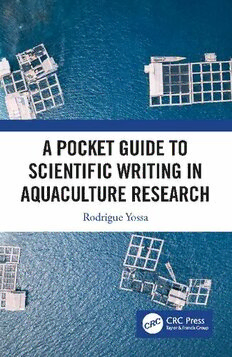
A Pocket Guide to Scientific Writing in Aquaculture Research PDF
Preview A Pocket Guide to Scientific Writing in Aquaculture Research
A Pocket Guide to Scientific Writing in Aquaculture Research A Pocket Guide to Scientific Writing in Aquaculture Research Rodrigue Yossa WorldFish, Penang, Malaysia & AquExperts International Inc., Ottawa, Ontario, Canada First edition published 2022 by CRC Press 6000 Broken Sound Parkway NW, Suite 300, Boca Raton, FL 33487-2742 and by CRC Press 2 Park Square, Milton Park, Abingdon, Oxon, OX14 4RN © 2022 Taylor & Francis Group, LLC CRC Press is an imprint of Taylor & Francis Group, LLC Reasonable efforts have been made to publish reliable data and information, but the author and pub- lisher cannot assume responsibility for the validity of all materials or the consequences of their use. The authors and publishers have attempted to trace the copyright holders of all material reproduced in this publication and apologize to copyright holders if permission to publish in this form has not been obtained. If any copyright material has not been acknowledged please write and let us know so we may rectify in any future reprint. Except as permitted under U.S. Copyright Law, no part of this book may be reprinted, reproduced, transmitted, or utilized in any form by any electronic, mechanical, or other means, now known or hereafter invented, including photocopying, microfilming, and recording, or in any information storage or retrieval system, without written permission from the publishers. For permission to photocopy or use material electronically from this work, access www. copyright.com or contact the Copyright Clearance Center, Inc. (CCC), 222 Rosewood Drive, Danvers, MA 01923, 978-750-8400. For works that are not available on CCC please contact m [email protected] Trademark notice: Product or corporate names may be trademarks or registered trademarks and are used only for identification and explanation without intent to infringe. Library of Congress Cataloging-in-Publication Data Names: Yossa, Rodrigue, author. Title: A pocket guide to scientific writing in aquaculture research / Rodrigue Yossa. Description: First edition. | Boca Raton, FL: CRC Press, 2022. | Includes bibliographical references and index. | Summary: “Writing a high-quality scientific aquaculture publication is challenging, and many students and early career aquaculture scientists find the task daunting. Yossa provides new researchers with all the tools they need to write abstracts and a variety of articles (peer-reviewed, technical, magazines, working papers, scientific reports and more). He talks the reader step-by-step through the process of reviewing submitted manuscripts and replying to reviewers, and understanding research ethics. Each section is accompanied by examples, offerings a lifeline to aquaculture students and early career academics getting to grips with the basics”— Provided by publisher. Identifiers: LCCN 2021036368 (print) | LCCN 2021036369 (ebook) | ISBN 9780367338879 (paperback) | ISBN 9780367338886 (hardback) | ISBN 9780429322648 (ebook) Subjects: LCSH: Aquaculture—Research—Handbooks, manuals, etc. | Technical writing—Handbooks, manuals, etc. | Handbooks and manuals. Classification: LCC PE1475 .Y67 2022 (print) | LCC PE1475 (ebook) | DDC 808.06/6—dc23 LC record available at https://lccn.loc.gov/2021036368 LC ebook record available at https://lccn.loc.gov/2021036369 ISBN: 978-0-367-33888-6 (hbk) ISBN: 978-0-367-33887-9 (pbk) ISBN: 978-0-429-32264-8 (ebk) DOI: 10.1201/9780429322648 Typeset in Palatino by codeMantra This book is dedicated to Gaelle Yossa Contents Foreword .................................................................................xi Preface ....................................................................................xiii Acknowledgments ................................................................xv Author ..................................................................................xvii 1. Introduction .....................................................................1 1.1 Why Writing Matters ............................................3 1.2 Who Should Write Publications ..........................5 1.3 What Is Writing Well? ..........................................7 1.4 What This Book Will Do for You ........................8 2. Principles of Scientific Writing ....................................9 2.1 How to Frame and Focus a Paper .......................9 2.2 Loopholes That One Has to Consider When Writing .......................................................10 2.3 Is English Grammar (Including Tenses) a Problem? .............................................................11 3. Ethics in Scientific Writing .........................................13 3.1 Being a Scientist ..................................................13 3.2 Originality of the Research.................................14 3.3 Citing a Source ....................................................15 3.3.1 Plagiarism ................................................16 3.3.2 Rule for Properly Copying and Pasting Published Information ......16 3.3.3 Rule for Properly Paraphrasing Published Information ..........................17 3.3.4 Rule for Properly Translating Published Information ..........................17 3.3.5 Self-Plagiarism ........................................18 3.4 Animal Ethics .......................................................18 vii viii Contents 4. Writing a Peer-Reviewed Original Article ..............21 4.1 Defining the Problem .........................................22 4.2 The Research Plan ...............................................22 4.3 Preparing a Manuscript .....................................24 4.4 Organization and Formatting ...........................25 4.4.1 Cover Page ..............................................26 4.4.2 Abstract ...................................................28 4.4.3 Introduction ............................................29 4.4.4 Materials and Methods .........................30 4.4.4.1 Fish ...........................................30 4.4.4.2 Facility .......................................31 4.4.4.3 Experimental Design ..............31 4.4.4.4 Feed and Feeding ....................31 4.4.4.5 Sample Collection and Analytical Procedures......32 4.4.4.6 Measurements and Calculations .....................32 4.4.4.7 Statistical Methods .................33 4.4.5 Results .....................................................45 4.4.6 Discussion ...............................................46 4.4.7 Acknowledgments .................................47 4.4.8 References ...............................................47 4.5 Summary of Tips for Good Scientific Writing ..................................................................48 5. Manuscript Submission ..............................................51 5.1 Choice of Outlet ...................................................51 5.2 Preparing/Formatting the Manuscript for Submission .....................................................52 5.3 Why Some Submitted Research Manuscripts Are Immediately Rejected ..........53 5.3.1 Is the Manuscript Complete? ...............54 5.3.2 Has All Identifying Information of the Co-authors Been Removed from the Manuscript Text? ...................55 Contents ix 5.3.3 Are All the Co-authors Listed in the Online Manuscript Submission System? ...............................55 5.3.4 Are the Citation and Reference Styles Correct? ........................................55 5.3.5 Are All the Changes Made on the Initial Manuscript Highlighted in the Revised Manuscript? ..................56 6. Reviewing a Manuscript for a Peer-Reviewed Journal.............................................................................59 6.1 Editorial Board and Peer Review Process ..................................................................60 6.2 The Principles of Manuscript Review in Aquaculture Research ...................................65 6.2.1 Analyzing the Introduction Section .......67 6.2.2 Analyzing the Materials and Methods Section .............................67 6.2.3 Analyzing the Results Section .............67 6.2.4 Analyzing the Discussion Section .....................................................68 6.2.5 Analyzing the Conclusion Section (or End of the Discussion Section if No Conclusion Section) .........................68 6.2.6 Analyzing the Title and Abstract Sections ....................................................68 6.3 Qualities Sought in a Peer Reviewer ................69 7. Preparing Authors’ Responses to Reviewers’ and Editors’ Comments ...............................................71 7.1 Revising the Manuscript as per the Reviewers’ and Editor’s Requests .....................72 7.2 Responding to Reviewer’s and Editors’ Comments ............................................................73 7.3 Formatting Authors’ Responses to Reviewers’ and Editors’ Comments .................75
